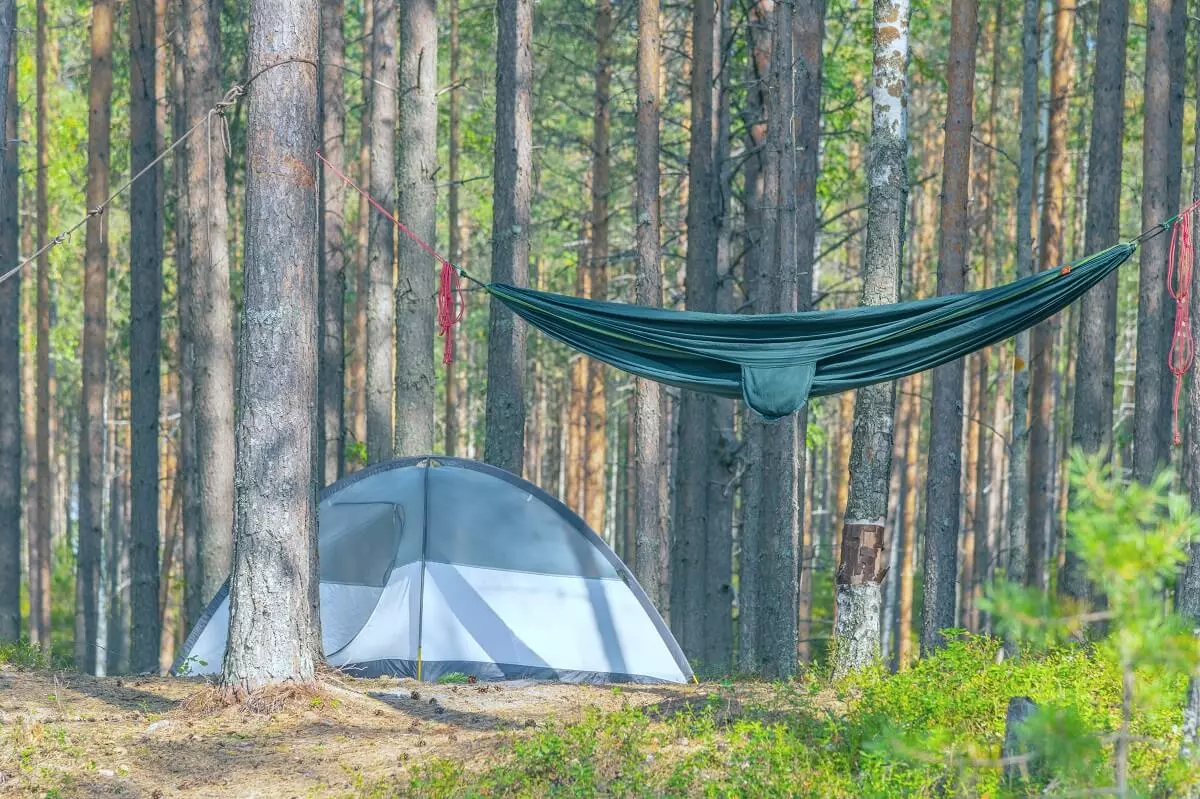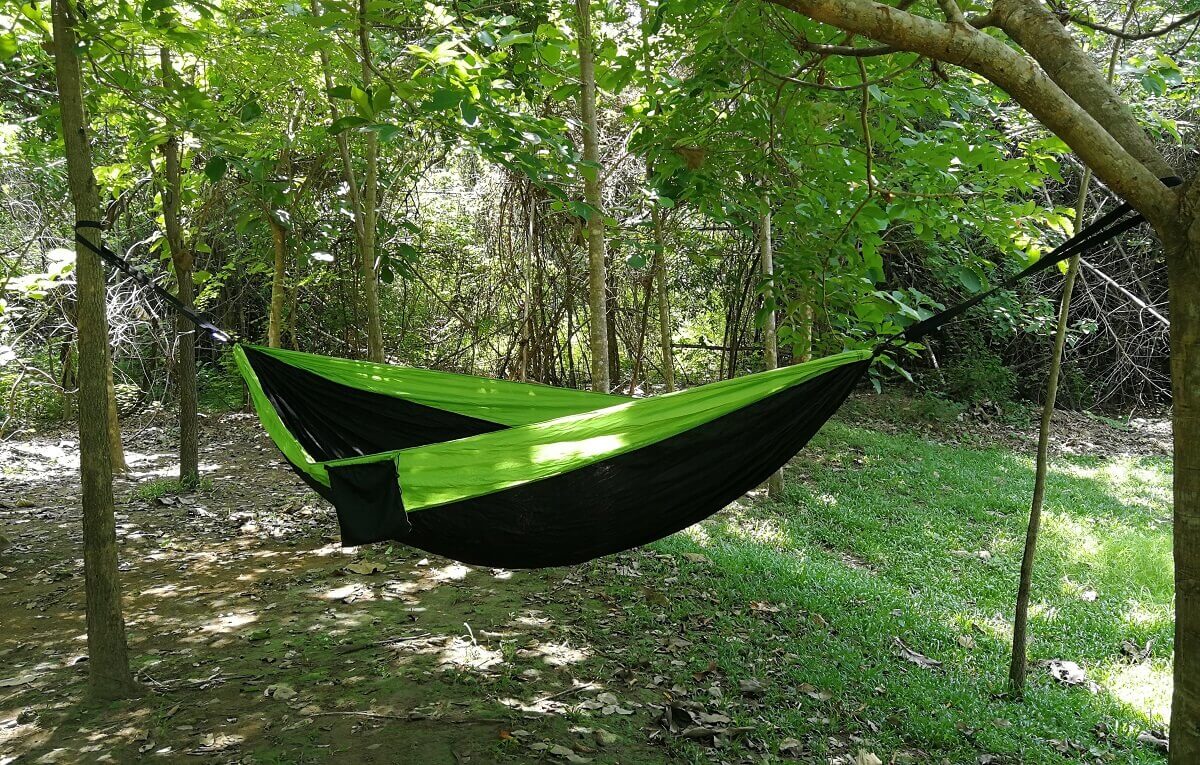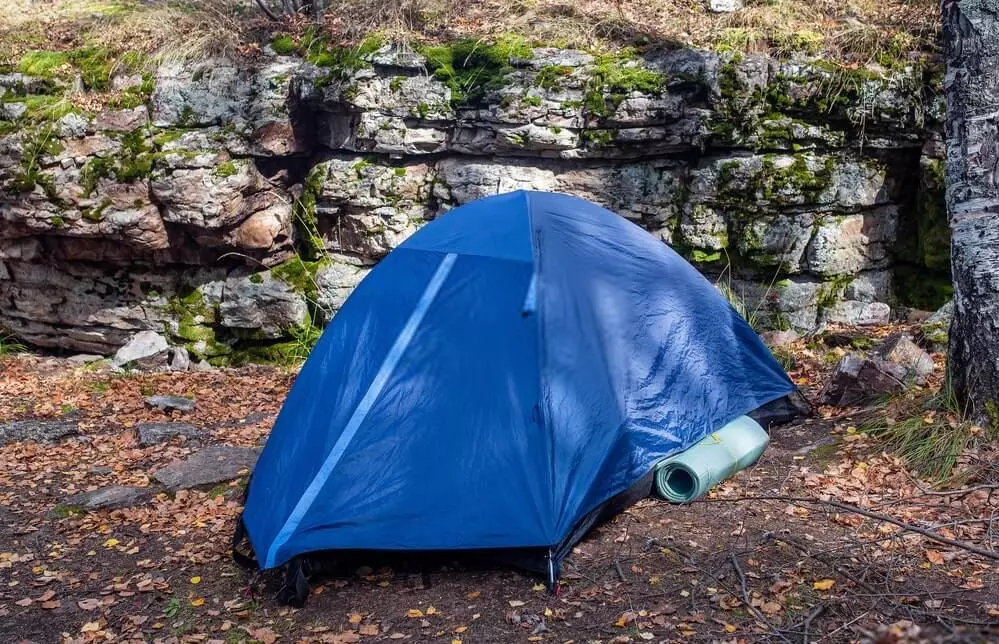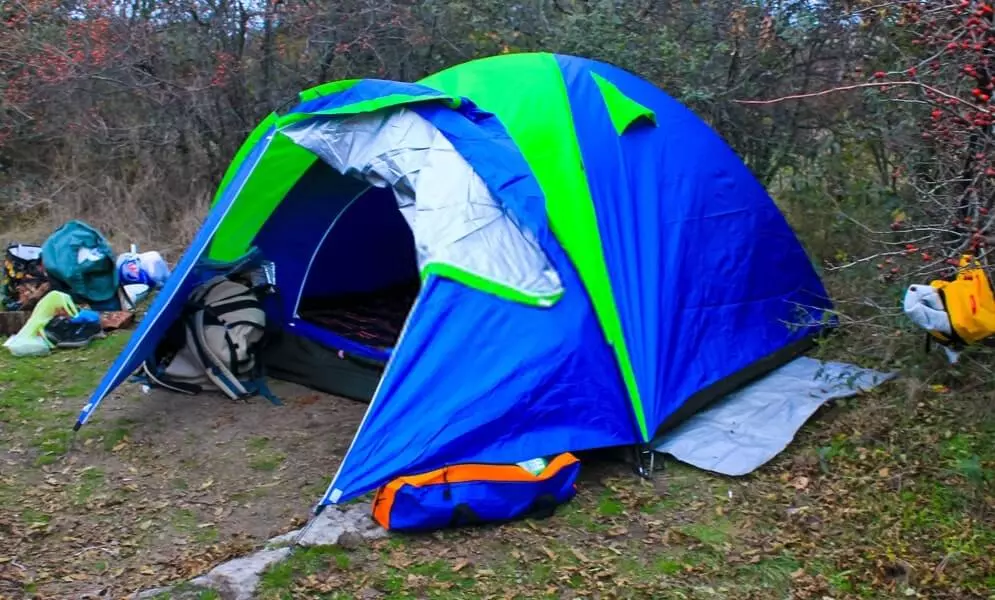- Camping Tips
- Hiking Tips
- RV Camping
- Destinations
- Blog
- Gear Reviews

The discussion on which is better for camping between hammocks and tents is never-ending and riddled with opinions and fewer facts. So, before you pick your side, a good place to start is by familiarizing yourself with the pros and cons of either of the two.
We will explore the limitations and strengths of the two in detail and hopefully help you make a better and informed decision.

Simply put, a hammock is a bed made of ropes, netting or fabric, suspended between two points (mostly trees). Its uses range from sleeping, resting to swinging. The popularity of hammocks can be credited to their extensive uses in El Salvador, Venezuela, Mexico, and India in the early days.
While modern hammocks are built to be more functional and comfortable, they still sport the classic design of their predecessors. Typically, there are about five types of hammocks namely; Mayan, rope, poolside, Brazil/Nicaragua-inspired, and quilted hammocks.
Camping hammocks will mostly be light and compact for easier transportation and mobility. They will also be made of sturdy flexible materials such as polyester, cotton, nylon and so on.
Tree-suspended versions will make more sense for camping. However, if you are more into glamping and have the luxury of space, you may consider hammocks with stands, swing chairs for relaxation, portable foldable hammocks, teardrop hammocks and hammocks with canopies.
That said, hammocks are the perfect choice for areas where pitching a tent would not be feasible, for instance, in rocky, steep terrains. Other arguments for hammocks are as discussed below:
Before we lock horns on which of the two is the fairest, let’s take a look at some factual and empirical comparisons that give hammocks an edge over ground camping.
Hammocks are usable regardless of weather conditions or terrain. Simply suspend the system by two points and you are set. They offer the best possible experience when it comes to above-the-ground sleeping.
You stay protected from creepy crawlies and ground moisture leaving you to doze off to the starry sky and nature sounds. No rodents, bugs or pests will dare disturb you as would be the case if you were sleeping on the ground.
Staying true to the Leave No Trace Principles, hammocks occupy very little footprint as compared to tents and other forms of camping. The hammock bundle is fairly lightweight, foldable and easily portable.
If you are a backpacker, you will also benefit from the minimalist bundle that hammocks pack into leaving you with more space for other camping essentials.
Likewise, the setups are pain-free for the most part as compared to the cumbersomeness of dealing with tent poles and stakes. With tents, you will have to find and prepare the area and fumble with the many components of the tent to set it up.
As long as there are suitable rocks, boulders or trees around, you can set up your hammock whenever and wherever. Gone will be the long nights of readjusting your sleeping bag on the ground due to the sudden rock or root protrusion.
On top of the relatively fast setups, you can easily set up the hammock in the same way throughout your camping trip. This is unlike tent camping where the campgrounds set the ground rules.
That said, setups can be somewhat difficult for first-timers for a couple of reasons.
The tarp and hammock needing to be set up autonomously, the hang angle of the hammock being hard to master, the tasking nature of estimating the tree size and distance to doing the knots accordingly (where necessary) are a few of the pain points associated with hammocks.
However, you will get the hang of it in no time and your setups will be much faster and consistent as compared to tent build-ups.
While there are hammocks and tents for all budgets, hammocks tend to be generally cheaper as they may not require many accessories. Tents act as the shell of the outdoor shelter and thus, all the inhouse items must be acquired.
However, hammocks will be the cheaper option for warm dry-weather camping as wet climates demand that you have underquilts, which can be very expensive.
Hammocks provide a comfy, flat surface that is very comfortable to lie on as compared to tent camping where rocks, sticks, and roots may interfere with your good night’s sleep. Subjectively, hammocks have been purpoted to ease back problems for most hikers and backpackers.
They also cradle your body and offer adequate support that is simply not possible in a tent.
Objectively, we look at comfort as the provision of warmth and uninterrupted sleep, which is perfected by hammocks. The above-ground sleeping system keeps cold and bugs out very effectively.
Most avid campers can also attest to hammocks sleeping cooler in hot climates and having zero condensation issues as compared to drippy tents. Interestingly, researchers have found that campers fall asleep quicker and sleep more soundly in hammocks thanks to the gentle rocking motion.
Together with the above benefits, hammocks will win you over with extras such as stargazing opportunities, exposure to fresh air, and relaxation pods. You may also use your hammock as a dry chair as you wait or take your meals.
Additionally, you may channel your inner child by literally rocking/swinging yourself to sleep or just relax to the pristine environments. Further, if you’re male and dreading getting out of bed to take a piss, worry not as you can scoot over to the edge of the hammock and relieve yourself.
Remember to unzip your sleeping bag first!
Another underrated benefit is that you have better visibility in hammocks than in tents. Animals or any unexpected visitors can be easily spotted when in a hammock as it’s easy to sit up and peer out whereas in a tent you’d have to get out.
Lastly, hammocks tend to be more durable than tents due to their single-piece construction. You simply have a single piece of fabric sewn on both ends devoid of the points of weaknesses in tents. There are no broken poles, jammed or split zipper systems or even punctured flooring.

While there may be two-person and family-size options, hammocks mostly hold one person. The sagging may cause a lot of discomforts when used by more than one person. Two-person hammocks are best suited for relaxing and lounging. This is not the case with tents.
Additionally, you can’t bring your gear inside your floating abode as it’s meant for sleeping only. This leaves your gear open to water damage and theft, which would be greatly minimized in a tent.
Hammocks mostly do well in calm, warm and dry weather conditions. Else, you’re better off with a tent. Winds will sway the hammock considerably to cause slight discomfort; a slight change of direction could easily spoil your night.
Additionally, hammocks require expensive underquilts to reduce heat loss during cold nights and tarps or rainfly to shield against rain and other falling elements such as leaves.
While you may be suspended safely away from menacing rodents, you are more prone to insect and mosquito bites when in a hammock than in a tent. That said, you can find hammocks with inbuilt nets in the market today.
Hammocks will need well-spaced stationary objects like trees and rocks which means that if you’re camping in the desert you’ll be out of luck. Camping above treeline may also be suited for tents and bivy sack/sleeping bag combos.
Primarily, hammocks were mostly used for relaxation and lounging on the beach or in other suitable areas. Therefore, they may not be well-equipped for sleeping purposes.
Side sleepers will, especially, have a rough time sleeping in a hammock and back sleepers may also wake up with an aching back if the hammock is not taut enough. Alike a skit out of a slapstick comedy, it’s also very possible to fall out of a hammock.
This may be due to the straps breaking or the straps winding as a result of vigorous swings.
The rocking motion is not always a welcome feature for many and it may actually make seemingly simple tasks very challenging. It becomes harder to change clothes or get out of bed due to the fidgety nature of the ropes and webbing.
Not to forget, hammocks do have a steep learning curve when setting up unlike tents.
Still, there are fewer manufacturers of hammocks and thus lesser options to consider.
Your ideal hammock setup should include a hammock, suspension points, tree hugger straps & toggles, underquilt & top-quilt, rain tarp or rainfly, sleeping bag, and mosquito net. If you still have some dollars left, consider getting some stakes as some hammocks have tie-outs as some of their suspension systems.
A hammock with an inbuilt mosquito net is more than recommended.
Clips under the hammock can help you hang your hiking backpack or other camping gear underneath.
That aside, you also need to learn how to hang your hammock. Key things to consider include the following:
Tools like the hammock calculator can be of great use in helping you set up the floating abode.
Preferably, ensure the straps are about 30 degrees relative to the ground below to allow for optimal sag. Also, the ridgeline should be approximately 83% of the overall hammock length excluding the straps.
Not to worry about the math of it all as most manufacturers will include an instructional manual with the calculations.

Tents have aged well as the go-to shelter option for camping as well as emergencies. They are favored over hammocks for their spaciousness, comfort, and sturdiness. New and seasoned campers are spoilt for choice on the many styles, sizes, and shapes of tents available today.
Types of tents range from classic ridge/A-frame, geodesic, pyramid, dome, and cabin shapes to multi-room, inflatable and instant models for festivals, families and car camping. Glamping is also not left behind thanks to the plush-looking bell and Tepee tents.
Tents offer a homey approach in sheltering you against the elements in the great outdoors. But why should you opt for a tent over a hammock?
It’s not a camp if it doesn’t have a tent, is it? Aside from the classic appeal and nostalgic effect that tents bring, here are some arguments for tents over hammocks.
Tents are designed to accommodate as many people as possible as long as you don’t mind the added weight and limited portability. You can get a two-person tent or even a family-sized version that will allow you to sleep comfortably next to your spouse, friends or kids.
This just isn’t possible in hammocks.
Tents are easy to set up, lightweight and reliable hence their continued usage over the years. You can set them up anywhere, even where there are no trees as long as it’s on suitable terrain. Open fields, meadows or even the desert are all up for grabs for tent campers.
Since you’re already used to sleeping on mats, sleeping pads, and mattresses, ground camping makes for an easy and natural transition. The tents will shield you from the elements and bugs.
Tents also offer a lot of convenience when it comes to maneuverability within the structure as well as routine tasks like changing clothes. Additionally, there’s more privacy in a tent than in a hammock.
You should always opt for tent camping if you need some extra space to store your camping gear or hiking boots. Inside the tent, your items will be at arm’s reach and well protected from water damage or theft.
Depending on the size of your tent, you may improve the comfort of your sleeping by adding a camping cot, sleeping pad or even an air mattress.
Tents offer more insulation than hammocks. Despite the tent material being slightly thin, the enclosed space entraps heat to keep you warm through cold nights. With tents, you can easily get away with a sleeping bag and while at it save yourself some money and payload. That just isn’t possible with hammocks, is it?
While mastering the art of site selection and tent setups will take time, clearing an area off rocks and sticks beats hunting for suitable rocks or trees to suspend your hammock. Tents from their inception were designed to be quick and foolproof.
Tents make for the most practical option when camping in cold or when boondocking. The added insulation and simple setups make tents the best option for all levels of campers.
As someone aptly put it, “people in sleeping bags are soft tacos of the bear world” and thus the more need to protect yourself with a better structure other than a hammock. Tents appear larger than hammocks and in effect confuse bears, mountain lions and wolves to not attack.
Also, modern tents are completely sealed off to keep out insects, snakes, mice, mosquitoes, and other critters.
Related: The ultimate camping safety guide for camping enthusiasts.

Pitching a tent will take more time as compared to suspending a hammock. It may be a two-man job and involves hitting in stakes and taking on the tent poles delicately to avoid breaking or bending them.
The tent poles form the skeleton of the tent. They occupy considerable space in your pack and can be very difficult to work with. If you are unfortunate enough to break or bend one, it can compromise the tent’s sturdiness and may even puncture the tent fabric.
The teardowns can be just as brutal and time-consuming especially with the tensed tent poles.
To avoid puncturing your tent floor or having lumps poking as you sleep, you need to find a level surface to pitch the tent. The area should have no rocks, humps or roots and be away from where rainwater pools.
Being on the ground also makes the tents susceptible to washout from heavy downpours. Plan and stay up-to-date on weather updates of the area you intend to camp at.
Tents may be bulkier than hammocks and may greatly impede portability. While a hammock can be fitted compactly into a stuff sack, the tent components require more storage space and a bigger bag for easier transportation.
Tents tend to get hot inside due to limited breathability provided by the tent material. Condensation is a major problem when it comes to tents and further, tents may not be suited for light traveling or light backpacking.
They also require a lot of tent care and maintenance to prolong their life, which includes adding tent footprints or tarps, general repairs and re-waterproofing the seams.
The tents versus hammocks battle boil down to a few aspects namely; comfort, price, size & weight, and ease of setup.
Our pick slightly leans on the tried-and-tested tents as shelters due to their homey features, warmth retention and relative ease of setup. Hammocks seem to be more tailored for casual relaxation and warm conditions whereas tents offer a more rounded purpose.
As nature lovers, hammocks seem to be the best implementation of the Leave No Trace movement as they offer alternative camping options to reduce the impact on popular campsites. Hammocks also don’t smother or crush plants and vegetation below them as is the case with tents.
To further the movement, make sure to use wide tree straps to protect the barks of the trees.
Aside from the obvious pros and cons of the two, there are limitations that either of them won’t circumvent.
Firstly, hammocks may be out of the equation in most national parks and campgrounds due to their specific rules and regulations. Some parks require that the hammocks be free-standing and not hang from trees or park structures, in which case a tent would be the best choice.
The use of hammocks will also be limited to areas with suitable trees and rocks for attachment. The distance between these trees and rocks can further complicate things.
Additionally, hammocks perform terribly in cold windy weather, even with a good-quality underquilt.
Tents also have their limitations, for instance, some campgrounds only permit pitching tents in existing campsites to reduce the impact on the environment. Also, the surface to pitch the tent shouldn’t be rocky, sloped, uneven or filled with twigs and root protrusions.
Tents and hammocks will also do little to protect you against wildlife (mostly bears), in which case RV camping would be the way to go.
Luckily, if you still can’t choose between the two, then why not enjoy the best of both worlds? After all, a hammock is lightweight and portable enough to add to your gear. Use the hammock for relaxation or interchangeably with the tent as a shelter/sleeping system.
Tents and hammocks are designed for different demographics and thus going for either will take a lot of agonizing if you don’t already have your preference. We advise that you try them both taking into account their distinct pros and cons before settling for either.
Charlie Leone
Website Owner/Editor
Welcome to CampingManiacs